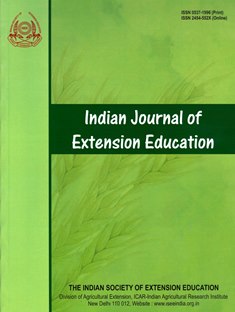Farmers Livelihood Security through Sheep Farming in Bareilly District of Uttar Pradesh
DOI:
https://doi.org/10.48165/IJEE.2025.61406Keywords:
Sheep farming, Livelihood security index, Socio-economic factors, Correlation analysis, Resource use efficiencyAbstract
The study was conducted in 2024 to assess the livelihood security of sheep-owning farmers in Bareilly district, Uttar Pradesh. A Livelihood Security Index (LSI) was developed based on five key dimensions: food and nutritional security, economic and marketing security, infrastructural security, social security, and resource use efficiency. Content validity and relevance were tested using scoring methods. Data were collected from farmers using a structured interview schedule, and LSI was computed through standardized scoring and weighted aggregation. Correlation analysis using SPSS (SPSS 26.0) identified the relationship between livelihood security and selected socio-economic variables. Results revealed that most farmers had a moderate level of livelihood security (composite index = 0.617), with resource use efficiency and economic security being the strongest areas. Income, education, flock size, extension contact, and knowledge had significant positive correlations with livelihood security, while credit access showed a negative correlation. The study concluded that targeted interventions in infrastructure, financial literacy, and behavioural capacity building are essential to enhance the livelihood resilience of smallholder sheep farmers.
Downloads
References
Alfares, H. K., & Duffuaa, S. O. (2008). Determining aggregate criteria weights from criteria rankings by a group of decision makers. International Journal of Information Technology & Decision Making, 7(4), 769–781.
Alinovi, L., D’errico, M., Mane, E., & Romano, D. (2010). Livelihoods strategies and household resilience to food insecurity: An empirical analysis to Kenya. European Report on Development, 1(1), 1–52.
Chambers, R., & Conway, G. (1992). Sustainable rural livelihoods: Practical concepts for the 21st century. Institute of Development Studies.
Chandana, T. S., Praveena, P. L. R. J., Lakshmi, T., Subramanyam, D., & Reddy, B. R. (2023). Sustainable livelihood security of integrated farming systems practicing farmers through different enterprise combinations in Andhra Pradesh. Indian Journal of Extension Education, 59(1), 101–106.
Chandegara, A. K., Chauhan, J. K., Upadhyay, A. U., Lahiri, B., Pandey, D. K., Pal, P., & Reena, H. (2024). A comparative analysis of livelihood security among fish and dairy farmers in Tripura, India. Indian Journal of Fisheries, 71(1), 135–143.
Chaudhari, R. U., Chauhan, N. M., & Chaudhary, K. L. (2023). Assessment of livelihood security of farmers in coastal area of South Gujarat. Gujarat Journal of Extension Education, 36(2), 134–137. https://www.gjoee.org/papers/1516.pdf
Chigadolli, M., Krishnamurthy, B., & Shivalingaiah, Y. N. (2020). Relationship and extent of contribution of profile of turmeric growers towards the adoption of improved cultivation practices in Belagavi, Karnataka. Indian Journal of Extension Education, 56(1), 28–33.
Dadabhau, A. S., & Gopal Sankhala, G. S. (2014). Development of an index for assessing the livelihood security status of farmers, 655–660.
Department for International Development (DFID). (1999). Sustainable livelihoods guidance sheets. London: DFID.
Edwards, A. L. (1957). Social desirability and probability of endorsement of items in the interpersonal check list. The Journal of Abnormal and Social Psychology, 55(3), 394.
Ellis, F. (2000). Rural livelihoods and diversity in developing countries. Oxford University Press.
Gautam, P. K., & Jha, S. K. (2023). Analysis of livelihood security of households: A case study from rural areas of Bundelkhand. Indian Journal of Extension Education, 59(1), 146–149.
Girish, C., Kadian, K., Meena, B., & Mandi, K. (2020). An assessment of livelihood security of farmers practicing sericulture-based dairy farming in Karnataka state. International Journal of Livestock Research, 10(6), 43–50.
Guilford, J. P. (1954). Psychometric methods. Tata McGraw Hill Publishing Co.
Kademani, S., Kameswari, V. L. V., Bhardwaj, N., & Amardeep. (2020). Relationship between selected characteristics of awardee farmers and extent of their opinion leadership. Journal of Community Mobilization and Sustainable Development, 15(1), 59–62.
Kaur, H., & Talukdar, R. K. (2007). Utility of farm women training programmes in livelihood security. Indian Research Journal of Extension Education, 7(2&3), 15.
Kumar, S., Shamna, A., & Jha, S. K. (2017). Adoption of production technologies among jute growers in West Bengal. Journal of Community Mobilization and Sustainable Development, 12(2), 216–222.
Kumar, S., Sharma, R. C., Bankoliya, M. K., & Singh, S. R. K. (2019). Correlates of improved production technology adoption for fetching maximum yield potentials of chickpea. Journal of Community Mobilization and Sustainable Development, 14(1), 183–187.
Mahadik, R. P., & Sawant, P. A. (2012). Livelihood security of tribal people in Thane district of Maharashtra. Rajasthan Journal of Extension Education, 20, 39–43.
Meshram, M., Singh, S. R. K., Dhenge, S. A., Meshram, V., & Shrivastava, P. (2024). Sustainable livelihood for tribal farmers via integrated farming system components. Agricultural Research, 1–18.
Mishra, B. P., Kanwat, M., Gupta, B. K., Meena, N. R., Mishra, N. K., & Kumar, P. S. (2020). Correlates of adoption of improved apiculture practices in Arunachal Pradesh. Indian Journal of Extension Education, 56(2), 51–54.
Mishra, M., Ravi, S. C., Verma, A. K., Gupta, A. K., Dubey, S. K., & Jaiswal, R. (2023). Assessing composite livelihood security and its determinants among rural households. Indian Journal of Extension Education, 59(2), 41–45.
Mohammad, A., Feroze, S. M., Dutta, T. K., Bhakat, C., & Chatterjee, A. (2023). Spatial variation in livelihood security among livestock-based agricultural farming systems in climatically vulnerable Indian Sundarbans. Tropical Animal Health and Production, 55(6), 372.
National Commission on Farmers (NCF). (2006). Year of agricultural renewal third report, serving farmers and saving farming. Retrieved from https://agriwelfare.gov.in/sites/default/files/NCF3%20%281%29.pdf
NSS. (2005). Report on socio-economic disparities in Madhya Pradesh. Poverty Monitoring and Policy Support Unit, State Planning Commission. Retrieved from https://discuss.forumias.com/uploads/FileUpload/70/d3269f81aed84456257d89ba50bc67.pdf
Pal, P. K., Bhutia, P. T., Das, L., Lepcha, N., & Nain, M. S. (2017). Livelihood diversity in family farming in selected hill areas of West Bengal, India. Journal of Community Mobilization and Sustainable Development, 12(2), 172–178.
Pradhan, S., Naberia, S., & Harikrishna, Y. V. (2021). Socio-economic correlates of livelihood security of small farmers in Jabalpur district of Madhya Pradesh. Indian Journal of Extension Education, 57(3), 57–59.
Pradhan, S., Naberia, S., Harikrishna, Y. V., & Jallaraph, V. (2020). Livelihood security of small farmers in Jabalpur district of Madhya Pradesh. Indian Journal of Extension Education, 56(4), 98–102.
Ramya, H. R., Satya Gopal, P. V., Prasad, S. V., & Raja, L. (2017). Characteristics determining the livelihood security of the tribal farmers. International Journal of Current Microbiology and Applied Sciences, 6(7), 4462–4470.
Scoones, I. (1998). Sustainable rural livelihoods: A framework for analysis. Institute of Development Studies.
Shruti, Sharma, J. P., Burman, R. R., Gills, R., & Singh, M. (2019). Scale construction to identify training needs of agripreneurs to enhance their competency for value chain development: A methodological approach. Journal of Community Mobilization and Sustainable Development, 33–40.
Singh, M., Singh, B. K., Singh, P., & Burman, R. R. (2018). Development of scale to measure attitude of farmers towards IARI-voluntary organizations partnership extension model: A methodological approach. Journal of Community Mobilization and Sustainable Development, 221–226.
Sunanda, T., Singh, M. K., Ram, D., & Chaudhary, K. P. (2014). Assessment of the sustainable livelihoods of Loktak Lake islanders in Bishnupur district of Manipur. Indian Research Journal of Extension Education, 14(3), 70–74.
Verma, H., Singh, M., Shruti, Chander, M., Meena, H. R., Saran, V., & Prabex, S. (2024). Development and validation of a scale to measure the attitude of sheep farmers towards scientific sheep husbandry. Journal of Community Mobilization and Sustainable Development, 19(4), 915–920.
Verma, H., Singh, M., Shruti, Chander, M., Meena, H. R., Saran, V., & Prabex, S. (2025). Construction and standardization of knowledge test for assessing scientific sheep farming practices. Indian Journal of Animal Health, 64(1), 63–72.
Downloads
Published
Issue
Section
License

This work is licensed under a Creative Commons Attribution-NonCommercial-NoDerivatives 4.0 International License.

